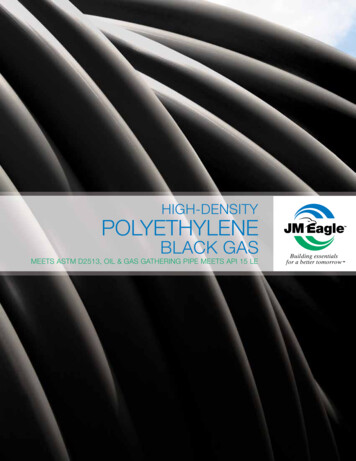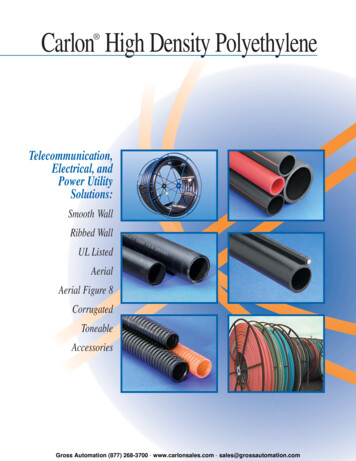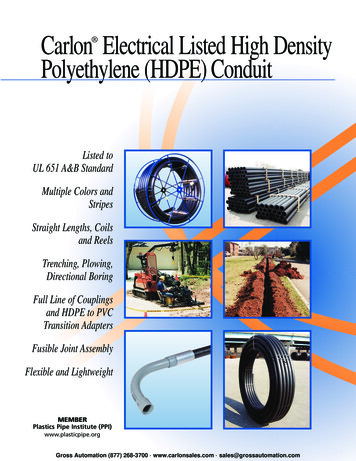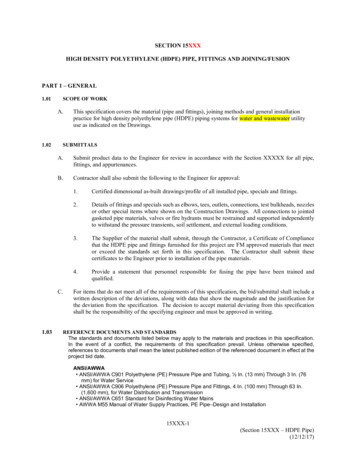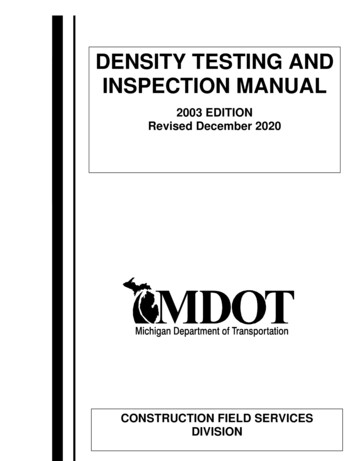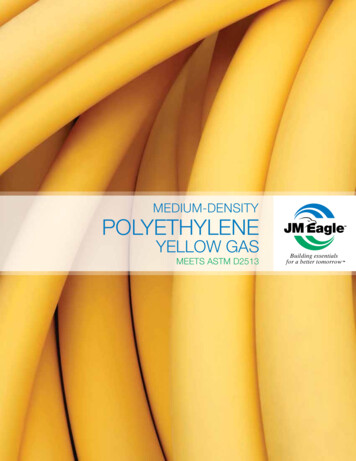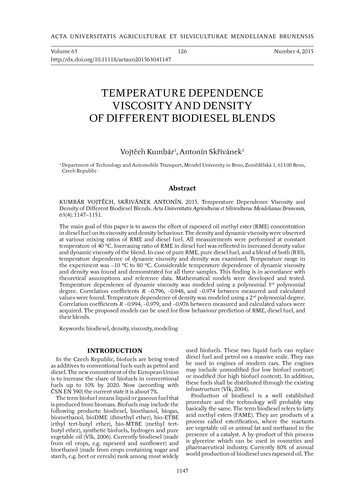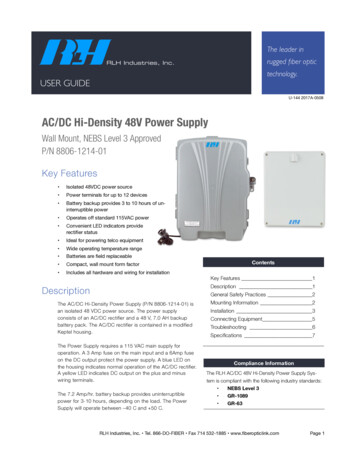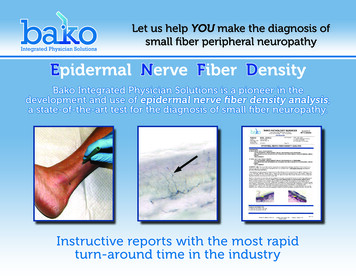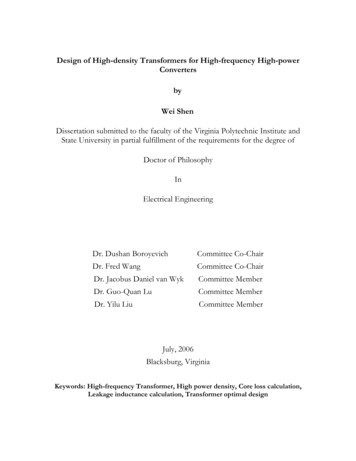
Transcription
Design of High-density Transformers for High-frequency High-powerConvertersbyWei ShenDissertation submitted to the faculty of the Virginia Polytechnic Institute andState University in partial fulfillment of the requirements for the degree ofDoctor of PhilosophyInElectrical EngineeringDr. Dushan BoroyevichCommittee Co-ChairDr. Fred WangCommittee Co-ChairDr. Jacobus Daniel van WykCommittee MemberDr. Guo-Quan LuCommittee MemberDr. Yilu LiuCommittee MemberJuly, 2006Blacksburg, VirginiaKeywords: High-frequency Transformer, High power density, Core loss calculation,Leakage inductance calculation, Transformer optimal design
Design of High-density Transformers for High-frequency High-powerConvertersWei ShenABSTRACTMoore’s Law has been used to describe and predict the blossom of IC industries,so increasing the data density is clearly the ultimate goal of all technologicaldevelopment. If the power density of power electronics converters can be analogized tothe data density of IC’s, then power density is a critical indicator and inherent drivingforce to the development of power electronics. Increasing the power density whilereducing or keeping the cost would allow power electronics to be used in moreapplications.One of the design challenges of the high-density power converter design is tohave high-density magnetic components which are usually the most bulky parts in aconverter. Increasing the switching frequency to shrink the passive component size is thebiggest contribution towards increasing power density. However, two factors, losses andparasitics, loom and compromise the effect. Losses of high-frequency magneticcomponents are complicated due to the eddy current effect in magnetic cores and copperwindings. Parasitics of magnetic components, including leakage inductances and windingcapacitances, can significantly change converter behavior. Therefore, modeling loss andparasitic mechanism and control them for certain design are major challenges and need tobe explored extensively.In this dissertation, the abovementioned issues of high-frequency transformers areexplored, particularly in regards to high-power converter applications. Loss calculationsaccommodating resonant operating waveform and Litz wire windings are explored.Leakage inductance modeling for large-number-of-stand Litz wire windings is proposed.The optimal design procedure based on the models is developed.ii
AcknowledgementsAcknowledgementsI owe an enormous debt of gratitude to my advisor, Dr. Dushan Boroyevich, forhis support and guidance during my study. His profound knowledge, masterly creativethinking, and sense of humor have been my source of inspiration through out this work.To Dr. Fred Wang, my co-advisor, I want to express my sincere appreciation tohim for his instruction, time, and patience. His gentle personality and rigorous attitudetoward research will benefit my career as well as my personal life. Most importantly, Ihave learned motivation and confidence from them. I am very lucky to have bothprofessors as mentors during my time in CPES.I would like to express my appreciation to my committee member, Dr. van Wyk,who is such an elegant and admirable professor. I enjoyed each of our meetings andalways learned more from him. I would also like to thank my other committee membersDr. Yilu Liu and Dr. Guo-Quan Lu for always helping and encouraging me.I would also like to thank all my colleagues in CPES for their help, mentorship,and friendship. I cherish the wonderful time that we worked together. Although this is nota complete list, I must mention some of those who made valuable input to my work. Theyare Dr. Bing Lu, Dr. Qian Liu, Dr. Gang Chen, Dr. Lingyin Zhao, Dr. Rengang Chen, Dr.Wei Dong, Dr. Shuo Wang, Dr. Ming Xu, Jerry Francis, Tim Thacker, Arnedo Luis,Dianbo Fu, Chuanyun Wang, Jinggen Qian, Liyu Yang, Manjin Xie, Yu Meng,Chucheng Xiao, Dr. Wenduo Liu, Michele Lim, Jing Xu, Yang Liang, Yan Jiang,Sebastian Rosado, Xiangfei Ma, Dr. Jinghong Guo, Dr. Zhenxian Liang, Dr. YingfengPang, Dr. Luisa Coppola, and so many others. The last but not the least, I want to thankgroup members of the ARL project: Hongfang Wang, Honggang Sheng, Dr. Xigen Zhou,Dr. Xu Yang, Yonghan Kang, Brayn Charboneau, Dr. Yunqing Pei, and Dr. Ning Zhu.I would like to thank the administrative staff members, Marianne Hawthorne,Robert Martin, Teresa Shaw, Trish Rose, Elizabeth Tranter, Michelle Czamanske, DanHuff, who always smiled at me and helped me to get things done smoothly.This work made use of ERC Shared Facilities supported by the National ScienceFoundation under Award Number EEC-9731677.iii
AcknowledgementsI dedicate this achievement to my wife Shen WangIt would not have been possible without your support, encouragement and love. Thankyou for being with me for the whole five years of study.Also to my parentsMr. Hancai Shen and Ms. Xiangdai Yangiv
Table of ContentsTable of ContentsABSTRACT. iiAcknowledgements. iiiChapter 1Introduction. 11.1. Background . 11.2. Literature Review . 31.2.1. Low power & Ultra-high frequency applications . 41.2.2. High power & mid-frequency applications. 51.2.3. Mid-power & High-frequency applications. 61.2.4. Summaries. 71.3. Research Scope and Challenges . 81.3.1. Research scope. 81.3.2. Research challenges . 91.4. Dissertation Organization. 10Chapter 2Nanocrystalline Material Characterization . 122.1. Conventional high-frequency magnetic materials. 132.1.1. Magnetic material introduction. 132.1.2. Characteristics of conventional ferri- and ferro-materials . 152.1.3. Ferrites . 152.1.4. Amorphous metals . 182.1.5. Supermalloy . 202.2. Characteristics of nanocrystalline materials. 212.2.1. B/H curve . 232.2.2. Loss performance. 262.2.3. Temperature dependence performance . 282.2.4. Cut core issues . 292.3. Summaries . 34Chapter 3Loss Calculation and Verification . 373.1. Core loss calculation . 383.1.1. Calculation method survey . 38v
Table of Contents3.1.2. Proposed loss calculation method. 413.2. Core loss measurement and verification . 523.2.1. Error analysis . 533.2.2. Loss verification for STS waveforms . 583.2.3. Summaries on core loss calculation. 663.3. Winding loss calculation . 663.3.1. AC resistance of Litz wire windings. 673.3.2. Litz wire optimal design . 713.4. Summaries . 73Chapter 4Parasitic Calculation . 744.1. Leakage inductance calculation. 744.1.1. Leakage inductance calculation method survey . 754.1.2. Proposed leakage inductance calculation method. 784.1.3. Verifications. 864.2. Winding capacitance calculation. 874.2.1. Simplified energy base calculation method . 884.2.2. Transformer winding capacitance calculation . 904.3. Summaries . 92Chapter 5The PRC System Case Study. 935.1. Transformer specifications of the PRC operation . 945.1.1. PRC operation analysis . 965.1.2. Transformer parameter determination . 995.2. Transformer minimum-size design procedure. 1025.2.1. Consideration of variable frequency effect. 1025.2.2. Minimum-size Design procedure. 1055.3. Prototyping and Testing Results. 1085.4. Summaries . 114Chapter 6Transformer Scaling Discussions . 1156.1. General scaling relationship . 1166.1.1. Size scaling . 1196.1.2. Frequency scaling . 123vi
Table of Contents6.1.3. Discussions . 1256.2. Power rating scaling for variable core dimensions. 1266.2.1. C-core characterization . 1266.2.2. PRC scaling designs. 1276.3. Summaries . 133Chapter 7Conclusions and Future Work . 1357.1. Conclusions . 1357.2. Future Work . 1367.2.1. Improve the Litz wire winding leakage inductance modeling. 1367.2.2. Extend the modeling and design work to EMI filter. 137References. 138Appendix I Arbitrary Waveform Generation. 151Appendix II Minimum-size Transformer Design Program . 155Appendix III C-core Shape Characteristic. 161vii
Table of FiguresTable of FiguresFig. 1-1 Status of the P*f (W*Hz) of power electronics converters based on differentsemiconductor materials and devices. 2Fig. 1-2 A typical charger converter system. 8Fig. 1-3 Transformer characteristics and technologies . 9Fig. 2-1 Ferrite 3F3 core loss density at 25 ºC [2-8]. 16Fig. 2-2 Ferrite 3F3 complex permeability as a function of frequency [2-8] . 16Fig. 2-3 Ferrite 3F3 B/H curve (top), initial permeability (middle) and loss density(bottom) as the function of temperature [2-8]. 18Fig. 2-4 Typical Fe- and Co-based amorphous materials core loss density at 25 ºC[2-11]. 19Fig. 2-5 Amorphous 2605-3A and 2714A impedance permeability as a function offrequency [2-11]. 20Fig. 2-6 Loss density of Supermalloy [2-13] . 21Fig. 2-7 Typical initial permeability and saturation flux density for soft magneticmaterials [2-16]. 22Fig. 2-8 The relation between coercivity and grain size of different ferromagneticmaterials. 22Fig. 2-9 B/H curve measurement setup. 23Fig. 2-10 B/H loop measured for FT-3M under 60 Hz. 25Fig. 2-11 Incremental permeability of the Finemet material . 25Fig. 2-12 B/H loops of the Finemet material under different frequencies. 26Fig. 2-13 Core loss density in mW/cm3 of the Finemet material. 27Fig. 2-14 Complex permeability as the function of frequency for the Finemetmaterial @ 0.1 T . 28Fig. 2-15 60 Hz B/H major and minor loops of the Finemet material under differenttemperature . 29Fig. 2-16 Flux density @ H 3A/m variation percentage (left) and initialpermeability variation percentage (right) as the function of the core temperature. 29Fig. 2-17 Core loss density as the function of the core temperature. 29Fig. 2-18 Finemet material C-core B/H loops (50 kHz) as the function of the lengthof air gap . 31Fig. 2-19 Core loss density of Finemet material and cut core using same material . 32Fig. 2-20 Core loss density as the function of the air gap length under frequency20kHz (top), 50kHz (middle), and 100kHz (bottom) . 33Fig. 2-21 Development road map for different soft magnetic materials. 34Fig. 2-22 Core loss density comparison of typical magnetic materials . 35Fig. 3-1 Voltage and flux of square and sinusoidal waveform . 42Fig. 3-2 Normalized flux density of triangle and sinusoidal waveforms. 43Fig. 3-3 Voltage and flux of the transform under a simplified STS waveform . 45Fig. 3-4 STS waveform with different shape and same peak flux level . 47Fig. 3-5 Loss calculated by different methods for the STS waveforms. 48Fig. 3-6 Calculated equivalent frequency by MSE for the STS waveforms. 48viii
Table of FiguresFig. 3-7 The PRC system for studying. 49Fig. 3-8 The transformer waveform of PRC with capacitor filter . 50Fig. 3-9 Variable duty cycle quasi-square voltage and corresponding flux waveforms. 52Fig. 3-10 The electrical core loss measurement setup . 53Fig. 3-11 The measured voltage and current under different frequencies . 56Fig. 3-12 The core loss measurement winding resistance . 57Fig. 3-13 The equivalent circuit of the core loss measurement setup. 57Fig. 3-14 Simulated current (top) and voltage (bottom) waveforms w/wo parasitics. 58Fig. 3-15 Generated STS waveforms (100 kHz) . 60Fig. 3-16 Core loss density of FT-3M nanocrystalline under STS waveforms (100kHz). 61Fig. 3-17 Measured and calculated Core loss density of under STS waveforms (100kHz and 0.4 T) . 62Fig. 3-18 Measured voltage and current for triangle excitation (100 kHz) (left) andthe corresponding B/H curve (right) . 63Fig. 3-19 Measured core loss density for triangle, square, and sine waveforms (100kHz). 63Fig. 3-20 Transformer waveform for the PRC circuit with resonant frequency 205kHz and variable switching frequency 100 kHz (left) and 200 kHz (right) . 64Fig. 3-21 Core loss density of 100 kHz sine, square, and PRC waveforms . 64Fig. 3-22 Voltage and current waveforms of 100 kHz sine, square, and PRCwaveform . 65Fig. 3-23 B/H loops of 100 kHz sine, square, and PRC waveforms. 66Fig. 3-24 Normalized resistance of Litz wire windings for 1 layer (upper) and 4layers (lower) . 69Fig. 3-25 AC/DC resistance ratio of Litz wire windings for 1 layer (upper) and 4layers (lower) . 71Fig. 4-1 Full bridge PWM converter (left) and Vds1 under different leakage values(right) . 75Fig. 4-2 Leakage field distribution of a pot core transformer. 76Fig. 4-3 Typical two-winding transformer structure and corresponding coordinationnotation . 79Fig. 4-4 Illustration and cross-section of a current-carrying semi-infinite plate . 80Fig. 4-5 Skin effect on magnetic field distribution (left) and current densitydistribution (right). 82Fig. 4-6 Illustration and cross-section of a current-carrying semi-infinite plate in aparallel field . 82Fig. 4-7 Proximity effect on magnetic field distribution (left) and current densitydistribution (right). 83Fig. 4-8 Eddy current effect on magnetic field distribution (right) of a two windingtransformer (left). 84Fig. 4-9 Litz wire approximation . 86Fig. 4-10 Leakage inductance by the proposed method (blue solid), the simplifiedmethod (pink solid), and measurement (black dots) . 87ix
Table of FiguresFig. 4-11 Illustration of two adjacent winding layers . 89Fig. 4-12 Winding structures – wave wiring (left) and leap wiring (right) . 90Fig. 4-13 Transformer terminal voltages (a) high-frequency equivalent circuit (b). 91Fig. 5-1 The three-level PRC converter for pulse power applications . 95Fig. 5-2 Capacitive filter half bridge PRC converter and resonant voltage and current. 97Fig. 5-3 Capacitive filter half bridge PRC converter normalized output characteristic. 98Fig. 5-4 Capacitive filter half bridge PRC converter normalized gain curve . 99Fig. 5-5 Hybrid charging schemes . 100Fig. 5-6 Capacitive filter half bridge PRC converter normalized gain curve . 101Fig. 5-7 30 kW hybrid charging trajectory . 102Fig. 5-8 Operating frequency (left) and V*S (right) of the application. 103Fig. 5-9 Calculated core loss profile within one charging . 104Fig. 5-10 Minimum size transformer design procedure. 105Fig. 5-11 Core loss (left) and winding loss (right) as function of flux density. 106Fig. 5-12 Optimal flux density for minimum total loss . 107Fig. 5-13 Total losses of the 30 kW transformer using different C-cores . 107Fig. 5-14 Transformer prototype structure. 109Fig. 5-15 30 kW ferrite core (left) and FT-3M nanocrystalline core (right)transformer prototypes . 110Fig. 5-16 30 kW PRC system with the nanocrystalline transformer . 110Fig. 5-17 Measured transformer primary voltage and current waveforms of the PRCduring charging (current channels with 1 A/V conversion ratio) . 111Fig. 5-18 The thermal network of the nanocrystalline transformer . 112Fig. 5-19 Calculated (top) and measured (bottom) temperature rises of thetransformer prototype for one charging operation . 113Fig. 5-20 Winding (top) and core (bottom) temperature rises of the transformerprototype for continuous charging operation. 113Fig. 6-1 Normalized transformer power density as function of SF (y 1, m 1,f 10kHz, Finemet FT-3M with α 1.62 and β 1.98 ) . 119Fig. 6-2 Normalized transformer power density as function of SF (y 0.5, m 1,f 10kHz, Finemet FT-3M with α 1.62 and β 1.98 ) . 120Fig. 6-3 Normalized transformer power density as function of SF (y 1, m 1,f 10kHz, Ferrite P with α 1.36 and β 2.86 ). 121Fig. 6-4 Normalized transformer power density as function of SF (y 0.5, m 1,f 10kHz, Ferrite P with α 1.36 and β 2.86 ). 121Fig. 6-5 Normalized transformer power density as function of SF (m 1, f 100kHz,Ferrite P with α 1.36 and β 2.86 ). 122Fig. 6-6 Normalized transformer power density as function of f (y 1, m 1, SF 1,Finemet FT-3M with α 1.62 and β 1.98 ). 123Fig. 6-7 Normalized transformer power density as function of f (y 0.5, m 1, SF 1,Finemet FT-3M with α 1.62 and β 1.98 ). 124Fig. 6-8 Normalized transformer power density as function of f (y 1, m 1, SF 1,Ferrite P with α 1.36 and β 2.86 ). 124x
Table of FiguresFig. 6-9 Normalized transformer power density as function of f (y 0.5, m 1, SF 1,Ferrite P with α 1.36 and β 2.86 ). 125Fig. 6-10 The C-core dimensions for scale design . 126Fig. 6-11 C-core window (left) and core (right) exposed area to volume ratios. 127Fig. 6-12 Calculated power densities of PRC transformers under differentfrequencies and power ratings, using ferrite P (a), Finemet FT-3M (b),Supermalloy (c), and Amorphous 2705M (d) as transformer cores . 130Fig. 6-13 Calculated power densities of PRC transformers under differentfrequencies and power ratings, using Finemet FT-3M as transformer cores. 132Fig. 6-14 Calculated power densities of PRC transformers for 200 kHz, usingFinemet FT-3M and Ferrite P as transformer cores. 133Fig. 7-1 Cylindrical coordinate consideration of the leakage field. 137xi
List of TablesList of TablesTable 1-1 Transformer design status. 7Table 2-1 Ferrites typical properties at 25ºC . 16Table 2-2 Amorphous material typical properties at 25ºC [2-11] . 19Table 2-3 Supermalloy material typical properties at 25ºC [2-13]. 21Table 2-4 Magnetic material characteristic comparison. 36Table 5-1 System Specifications. 94Table 5-2 PRC operation mode analysis. 97Table 5-3 Transformer design specs and parameters. 109Table 6-1 PRC specifications for different ratings and frequencies . 128Table 6-2 Magnetic material characteristics . 128Table 6-3 Transformer scaling-design results for different materials . 129Table 6-4 Transformer scaling-design results for the integrated scheme . 131xii
Chapter 1. IntroductionChapter 1IntroductionTransformer design is not a new topic, and the corresponding studies have beenconducted along the development of the power systems and power conversiontechnologies. This work focuses on the high density transformer design for highfrequency and high-power applications. In this chapter, a background description andreview will help to define this work and its novelty. Furthermore, we will identifychallenges related to the transformer design of the interested frequency and power ranges.1.1.BackgroundThe apparatus Michael Faraday constructed in 1831 contained all the basicelements of transformers: two independent coils and a closed iron core. Since then,transformers have come into our ordinary lives as an essential part of AC lightingsystems [1-1]. Power transformers, including transmission and distribution ones, usuallyhave efficiency close to 100%. The development of cheaper and more reliabletransformers is the goal of the power system industry.Power electronics converters mainly employ transformers, for the purposes ofgalvanic isolation and voltage level changing, which are quite similar to the powersystem requirements. However, transformers for switching mode converters have distinctcharacteristics, like high operating frequencies, non-sinusoidal waveforms, andpredominantly compact sizes. In practice, the transformer is a complex component, oftenat the heart of circuit performance. The design and performance of the transformer itselfrequires a deeper understanding of electromagnetism [1-2].Together with other passive components, transformers dominate the size of thepower circuit [1-3]. For the past two decades, high power density has been the maintheme to the power electronics development in distributed power systems, vehicularelectric systems, and consumer apparatus [1-4]. Increasing frequency that is driven by thedesire to shrink passive size, in turn imposes the investigation on the design of highfrequency pas
Keywords: High-frequency Transformer, High power density, Core loss calculation, Leakage inductance calculation, Transformer optimal design . Design of High-density Transformers for High-frequency High-power Converters Wei Shen ABSTRACT Moore’s Law has been u
